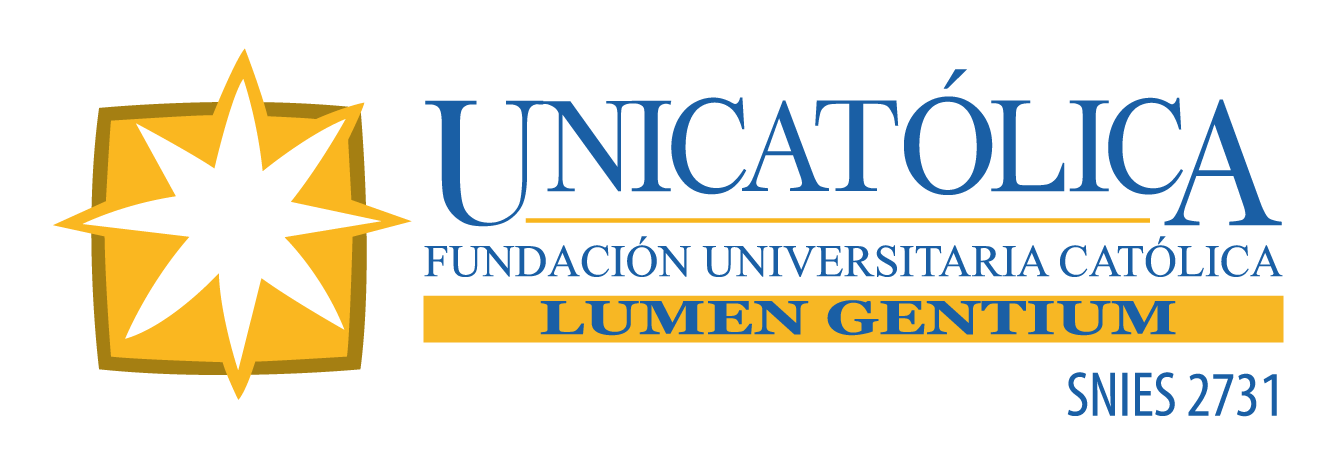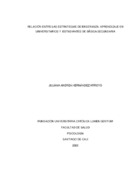Mostrar el registro sencillo del ítem
Relación entre las estrategias de enseñanza- aprendizaje en universitarios y estudiantes de básica secundaria
| dc.contributor.advisor | Ayala Galindo, Chris Ángela | |
| dc.creator | Hernández Arroyo, Juliana Andrea | |
| dc.date.accessioned | 2020-08-28T00:11:11Z | |
| dc.date.available | 2020-08-28T00:11:11Z | |
| dc.date.created | 2020 | |
| dc.identifier.uri | http://hdl.handle.net/20.500.12237/1910 | |
| dc.description | Esta investigación de carácter cuantitativo descriptivo tiene como objetivo de estudio analizar la relación entre las estrategias de aprendizaje empleadas por estudiantes y las estrategias motivacionales al enseñar, impartidas por el personal docente en su cátedra, teniendo en cuenta los modelos pedagógicos existentes desde un enfoque cognitivo en el campo educativo. Esta investigación se focalizó en dos grupos de estudio, con el fin de medir la asimilación de los estudiantes expuestos a distintos tipos de estrategias motivacionales en diferentes momentos formativos; los grupos evaluados corresponden a una institución de básica secundaria de carácter público y otra universitaria de carácter privado, siendo analizados tanto estudiantes como educadores de los mismos grupos. Para conocer el tipo de estrategias de aprendizaje que emplean los estudiantes con mayor frecuencia se implementó la fase 1 del proyecto, en esta se analizó unamuestra de 43 estudiantes de grado 11 de la Institución Técnico Industrial Multipropósito y 149 estudiantes del programa de psicología de la Fundación Universitaria Católica Lumen Gentium de tercer, séptimo y noveno semestre. La segunda fase indaga sobre los tipos de estrategias motivacionales que emplean los docentes al momento de impartir sus clases. Para lograr este objetivo se seleccionaron 23 formadores de grado once de la Institución Educativa Técnico Industrial Multipropósito y 26 docentes de la Fundación Universitaria Católica Lumen Gentium de tercer, séptimo y noveno semestre del programa de psicología. Para el desarrollo del primer objetivo, se aplicó el instrumento ACRA el cual indaga por lo tipos de estrategias que emplean los estudiantes para aprender desde un enfoque cognitivo, clasificando las estrategias en cuatro categorías de aprendizaje: adquisición, codificación, recuperación de la información y las estrategias de apoyo al procesamiento. Para la implementación del segundo objetivo, fue necesario desarrollar un instrumento que cubriera los objetivos de estudio para el grupo de los docentes, dicho instrumento fue diseñado por la estudiante a cargo de la investigación bajo el título “escalas motivacionales por parte del cuerpo docente E.M.D” este cuestionario evaluativo busca conocer qué tipo de estrategias motivacionales usan con mayor frecuencia los educadores entre las categorías: motivación hacia el aprendizaje, motivación hacia la tarea y la entretención. Después de aplicados los instrumentos a los diferentes grupos de estudio se encontraron resultados importantes que podrían interés para la realización de estudios posteriores. En la institución universitaria se halló una tendencia contundente de casi el 100% de los agentes educativos que enfocan sus estrategias motivacionales de enseñanza hacia el aprendizaje, esto supone pensar en una enseñanza en pro de la indagación y estímulos continuos para generar una motivación intrínseca en el alumnado, con el objetivo de crear aprendizajes significativos y duraderos en el tiempo, este tipo de enseñanza se basa en un modelo pedagógico autoestructurante en el que el estudiante toma un rol activo en el conocimiento. Por su parte, las respuestas de los estudiantes a este estímulo motivacional fue distribuido entre las cuatro escalas del instrumento ACRA donde se halló que los estudiantes utilizan: adquisición con un 53%, codificación 33%, estrategias de recuperación de la información 34% y apoyo al procesamiento con un 36%. Se halla una fuerte tendencia de más del 50% de los estudiantes encuestados a las estrategias de adquisición, lo que puede indicar indicios de un aprendizaje de forma memorística. En contraste con esta información en el contexto educativo de secundaria, se focaliza la tendencia hacia las estrategias motivacionales de entretención, estas buscan de forma continua utilizar los recursos pedagógicos hacia la generación de agrado por parte de los estudiantes para que deseen aprender. En cuestión de aprendizaje, los estudiantes denotan estrategias de apoyo al procesamiento con un 55% de los encuestados, por lo que se puede observar una tendencia hacia el modelo pedagógico interestructurante, según Zubiría (2006) los docentes dirigen sus estrategias pedagógicas a potenciar habilidades de la vida, desde el actuar, sentir y pensar. Por último se indagó por la relación entre los dos tipos de estrategias utilizadas por los docentes y los estudiantes. Para esto, se segmentó la información recolectada de la muestra estudiantil de ambas instituciones por semestre/curso y se comparó con los docentes correspondientes a cada nivel. Es así como se identificó una tendencia del 99% del personal educativo universitario que enfoca sus estrategias motivacionales hacia el aprendizaje. A pesar de encontrarse un nivel alto en este tipo de motivación, los estudiantes de tercer y séptimo semestre no demuestran altos porcentajes en estrategias de aprendizaje más significativas para el aprendizaje a largo plazo como la codificación y recuperación de la información, por el contrario se evidencia una tendencia hacia las estrategias de adquisición con un 60% para tercer semestre y 48% en séptimo. En contraste con los dos semestres analizados, los estudiantes de noveno semestre demuestran una fuerte tendencia hacia las estrategias de recuperación de la información con un 42%, lo que supone pensar en aprendizajes y conocimientos más significativos con duración en el tiempo. Finalmente, se encuentran los estudiantes de grado once, los cuales tienden a un uso de estrategias de apoyo al procesamiento con un 55% lo que denota un enfoque hacia la resolución de conflictos, estrategias afectivas y sociales. En cuanto a los maestros, se observa tendencia hacia las estrategias de entretención. Finalmente se concluye que los estudiantes universitarios hacen mayor uso de estrategias de adquisición en tercero y séptimo semestre. Sin embargo, se observa un cambio de patrones de aprendizaje en cuanto a sus estrategias de aprendizaje con el paso del tiempo como se evidencia en noveno semestre, mostrando estrategias ligadas a la recuperación de información, lo que se relaciona de forma directa con el tipo de motivación hacia el aprendizaje del personal docente. En cuanto a la educación básica secundaria, se encuentran patrones de los estudiantes por las estrategias de apoyo y de adquisición en grado once. Los docentes hacen uso de estrategias de entretención lo que puede estar influenciado por las características de la población | spa |
| dc.description.abstract | The objective of this descriptive quantitative research study is to analyze the relationship between the learning strategies used by students and the motivational strategies when teaching, taught by the teaching staff in their chair, taking into account the pedagogical models affected from a cognitive approach in the educational field. This research focused on two study groups, in order to measure the assimilation of the affected students to different types of motivational strategies at different formative moments; The evaluated groups correspond to a public secondary institution and another private university, both students and educators from the same groups being analyzed. To know the type of learning strategies that students use most frequently, implement phase 1 of the project, in which a sample of 43 11th grade students from the Multipurpose Industrial Technical Institution and 149 students from the psychology program of the Third, seventh and ninth semester Lumen Gentium Catholic University Foundation. The second phase investigates the types of motivational strategies that teachers use when teaching their classes. To achieve this objective, 23 eleventh grade trainers from the Multipurpose Industrial Technical Educational Institution and 26 teachers from the Lumen Gentium Catholic University Foundation of the third, seventh and ninth semesters of the psychology program were selected. For the development of the first objective, the ACRA instrument was applied, which investigates the types of strategies that students use to learn from a cognitive approach, classifying the strategies into four learning categories: acquisition, coding, information retrieval and processing support strategies. For the implementation of the second objective, it was necessary to develop an instrument that covered the study objectives for the group of teachers. This instrument was designed by the student in charge of the investigation under the title "motivational scales by the EMD faculty" This evaluative questionnaire seeks to know what type of motivational strategies educators use most frequently among the categories: motivation towards learning, motivation towards homework and entertainment. After applying the instruments to the different study groups, important results were found that could be of interest for subsequent studies. In the university institution, a forceful trend was found of almost 100% of the educational agents who focus their motivational teaching strategies towards learning, this means thinking about teaching in favor of inquiry and continuous stimuli to generate an intrinsic motivation in the Students, with the aim of creating meaningful and lasting learning over time, this type of teaching is based on a self-structuring pedagogical model in which the student takes an active role in knowledge. On the other hand, the students' responses to this motivational stimulus was distributed among the four scales of the ACRA instrument, where it was found that the students use: acquisition with 53%, coding 33%, information retrieval strategies 34% and support. to processing with 36%. There is a strong tendency of more than 50% of the surveyed students to acquisition strategies, which may indicate indications of learning in a memorized way. In contrast to this information in the secondary educational context, the trend towards motivational strategies of entertainment is focused, they continuously seek to use pedagogical resources towards the generation of liking by students so that they want to learn. In terms of learning, students denote processing support strategies with 55% of the respondents, so a trend towards the interstructuring pedagogical model can be observed, according to Zubiría (2006) teachers direct their pedagogical strategies to enhance skills of life, from acting, feeling and thinking. Finally, the relationship between the two types of strategies used by teachers and students was investigated. For this, the information collected from the student sample of both institutions was segmented by semester / course and compared with the corresponding teachers at each level. This is how a trend of 99% of university educational personnel who focus their motivational strategies towards learning was identified. Despite being at a high level in this type of motivation, third and seventh semester students do not demonstrate high percentages in more significant learning strategies for long-term learning such as coding and retrieving information, on the contrary it is evident a trend towards acquisition strategies with 60% for the third semester and 48% in the seventh. In contrast to the two semesters analyzed, the ninth semester students show a strong tendency towards information retrieval strategies with 42%, which means thinking about more significant learning and knowledge with duration over time. Finally, there are the eleventh grade students, who tend to use strategies to support processing with 55%, which denotes an approach towards conflict resolution, affective and social strategies. As for teachers, there is a trend towards entertainment strategies. Finally, it is concluded that university students make greater use of acquisition strategies in the third and seventh semester. However, a change in learning patterns is observed in terms of their learning strategies over time as evidenced in the ninth semester, showing strategies linked to information retrieval, which is directly related to the type of motivation towards the learning of the teaching staff. Regarding basic secondary education, patterns of students are found for support and acquisition strategies in grade eleven. Teachers use entertainment strategies which may be influenced by the characteristics of the population. | spa |
| dc.format.mimetype | application/pdf | spa |
| dc.subject | Estrategias de aprendizaje | spa |
| dc.subject | Estrategias motivacionales | spa |
| dc.subject | Motivational strategies | spa |
| dc.title | Relación entre las estrategias de enseñanza- aprendizaje en universitarios y estudiantes de básica secundaria | spa |
| dc.subject.subjectenglish | Learning strategies | spa |
| dc.rights.accessRights | info:eu-repo/semantics/openAccess | spa |
| dc.creator.degree | Psicólogo | spa |
Ficheros en el ítem
Este ítem aparece en la(s) siguiente(s) colección(ones)
-
Psicología [203]

